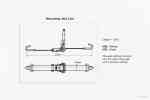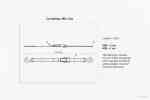Step 1 of 5•2 minutes read
The Cargo Securing Manual
The Cargo Securing Manual (CSM) is individually made for each specific vessel. It shall be based on the type of equipment used and accelerations that can be expected in various positions. It shall give detailed instructions on how cargo units loaded onboard shall be secured to the vessel's deck to prevent cargo shifting.
As mentioned earlier in the course, the Cargo Securing Manual shall consist of the following major sections:
- Fixed equipment.
- Portable equipment.
- Accelerations.
- Cargo-specific instructions.
Fixed Equipment
All fixed equipment for cargo securing shall be listed within the CSM, for example, clover leaves, D-rings, crinkle bars and lashing holes.
A graphic display, together with information about the strength (MSL) of the equipment, can normally be found in this chapter.
Please note that only the equipment described in this chapter is allowed to be used for Cargo securing onboard the vessel under normal operations. If additional equipment is installed onboard, for example, welded lashing eyes, etc. they are only allowed to be used for cargo securing with permission from the Master.

The primary lashing points on all decks and internal ramps are cloverleaf lashing pots. The clover leaves are located on the sides of each lane.
The clover leaves are constructed for the strength of MSL 2 x 125 kN. Therefore, four pieces of chain lashings with MSL 100 kN can be placed into each cloverleaf lasing point, as seen in the picture below.
The distance between the clover leaves varies, but it is usually around 2.25 meters in the longitudinal direction and around 2.95 meters in the transverse direction.

Photo showing a fixed clover leaf lashing point providing securing for four lashings without compromising the safety of the loads.
Portable Equipment
In this chapter, all portable cargo securing equipment used onboard shall be listed, for example, web or chain lashings, trestles, jacks, etc.
A drawing/picture and information about the length and strength (MSL) of the portable equipment can normally be found in this chapter of the CSM.
Please note that only portable equipment that is described in the CSM is allowed to be used for cargo securing.



